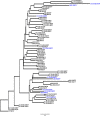Genetic variation of the HIV-1 subtype C transmitted/founder viruses long terminal repeat elements and the impact on transcription activation potential and clinical disease outcomes
- PMID: 37307292
- PMCID: PMC10289673
- DOI: 10.1371/journal.ppat.1011194
Genetic variation of the HIV-1 subtype C transmitted/founder viruses long terminal repeat elements and the impact on transcription activation potential and clinical disease outcomes
Abstract
A genetic bottleneck is a hallmark of HIV-1 transmission such that only very few viral strains, termed transmitted/founder (T/F) variants establish infection in a newly infected host. Phenotypic characteristics of these variants may determine the subsequent course of disease. The HIV-1 5' long terminal repeat (LTR) promoter drives viral gene transcription and is genetically identical to the 3' LTR. We hypothesized that HIV-1 subtype C (HIV-1C) T/F virus LTR genetic variation is a determinant of transcriptional activation potential and clinical disease outcome. The 3'LTR was amplified from plasma samples of 41 study participants acutely infected with HIV-1C (Fiebig stages I and V/VI). Paired longitudinal samples were also available at one year post-infection for 31 of the 41 participants. 3' LTR amplicons were cloned into a pGL3-basic luciferase expression vector, and transfected alone or together with Transactivator of transcription (tat) into Jurkat cells in the absence or presence of cell activators (TNF-α, PMA, Prostratin and SAHA). Inter-patient T/F LTR sequence diversity was 5.7% (Renge: 2-12) with subsequent intrahost viral evolution observed in 48.4% of the participants analyzed at 12 months post-infection. T/F LTR variants exhibited differential basal transcriptional activity, with significantly higher Tat-mediated transcriptional activity compared to basal (p<0.001). Basal and Tat-mediated T/F LTR transcriptional activity showed significant positive correlation with contemporaneous viral loads and negative correlation with CD4 T cell counts (p<0.05) during acute infection respectively. Furthermore, Tat-mediated T/F LTR transcriptional activity significanly correlated positively with viral load set point and viral load; and negatively with CD4 T cell counts at one year post infection (all p<0.05). Lastly, PMA, Prostratin, TNF-α and SAHA cell stimulation resulted in enhanced yet heterologous transcriptional activation of different T/F LTR variants. Our data suggest that T/F LTR variants may influence viral transcriptional activity, disease outcomes and sensitivity to cell activation, with potential implications for therapeutic interventions.
Copyright: © 2023 Madlala et al. This is an open access article distributed under the terms of the Creative Commons Attribution License, which permits unrestricted use, distribution, and reproduction in any medium, provided the original author and source are credited.
Conflict of interest statement
The authors have declared that no competing interests exist.
Figures





Similar articles
-
Platelet-rich therapies for musculoskeletal soft tissue injuries.Cochrane Database Syst Rev. 2014 Apr 29;2014(4):CD010071. doi: 10.1002/14651858.CD010071.pub3. Cochrane Database Syst Rev. 2014. PMID: 24782334 Free PMC article. Review.
-
Falls prevention interventions for community-dwelling older adults: systematic review and meta-analysis of benefits, harms, and patient values and preferences.Syst Rev. 2024 Nov 26;13(1):289. doi: 10.1186/s13643-024-02681-3. Syst Rev. 2024. PMID: 39593159 Free PMC article.
-
Dynamic Field Theory of Executive Function: Identifying Early Neurocognitive Markers.Monogr Soc Res Child Dev. 2024 Dec;89(3):7-109. doi: 10.1111/mono.12478. Monogr Soc Res Child Dev. 2024. PMID: 39628288 Free PMC article.
-
Evaluating Different Types of Cancer Survivorship Care [Internet].Washington (DC): Patient-Centered Outcomes Research Institute (PCORI); 2019 Jul. Washington (DC): Patient-Centered Outcomes Research Institute (PCORI); 2019 Jul. PMID: 39602557 Free Books & Documents. Review.
-
Infliximab for maintenance of medically-induced remission in Crohn's disease.Cochrane Database Syst Rev. 2024 Feb 19;2(2):CD012609. doi: 10.1002/14651858.CD012609.pub2. Cochrane Database Syst Rev. 2024. PMID: 38372447 Review.
References
-
- Lyles RH, Munoz A, Yamashita TE, Bazmi H, Detels R, Rinaldo CR, et al.. Natural history of human immunodeficiency virus type 1 viremia after seroconversion and proximal to AIDS in a large cohort of homosexual men. Multicenter AIDS Cohort Study. J Infect Dis. 2000;181(3):872–80. doi: 10.1086/315339 - DOI - PubMed
-
- Claiborne DT, Prince JL, Scully E, Macharia G, Micci L, Lawson B, et al.. Replicative fitness of transmitted HIV-1 drives acute immune activation, proviral load in memory CD4+ T cells, and disease progression. Proc Natl Acad Sci U S A. 2015;112(12):E1480–9. doi: 10.1073/pnas.1421607112 - DOI - PMC - PubMed
MeSH terms
Substances
Grants and funding
LinkOut - more resources
Full Text Sources
Medical
Research Materials
Miscellaneous

